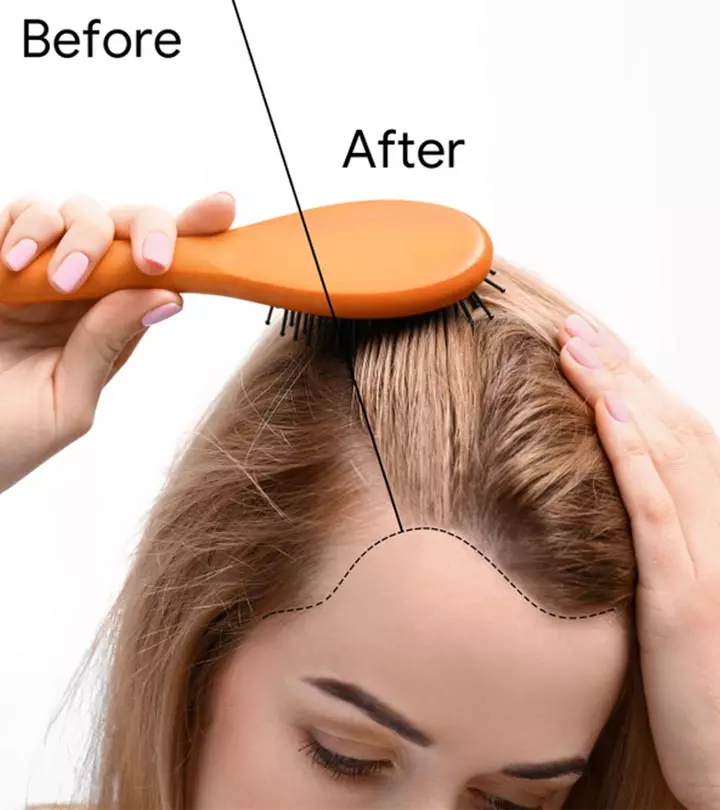Hair Transplants: Cost, Types, Risks, And Complications
A complete guide to decoding and understanding the cost of hair transplants.

Image: Shutterstock
Are you experiencing hair loss and tried several home remedies, but nothing worked? Thinking about transplantation but worried about hair transplant cost? Dealing with hair loss causes mental stress too. Most of the hair products available on the market give false promises or provide only short-term solutions, which are of no use. Everyone needs a permanent solution, and a hair transplant is a consistent method that provides an effective solution. This article discusses the different types of hair transplant procedures, their cost, recovery time, risks, and more. Keep on reading to know more.

In This Article
How Much Does A Hair Transplant Cost?
The cost of a hair transplant can range from $5000 to $20,000, depending on the type of procedure. The two most popular procedures for hair transplant are FUE (follicular unit extraction) or FUT (follicular unit transplantation). FUT may be cheaper than FUE. However, the surgeon determines which procedure is best suited for you (1).
There are different factors that influence the cost of hair transplants:
- Surgeon: Since it is a highly skill-based procedure, the cost is definitely controlled by the surgeon, their experience, and their client testimonials. Brand name clinics offer standard rates and may offer discounts from time to time. It is important to look at the client diaries and read up on the recovery procedures before you finalize on the surgeon.
- Quantity: The amount of hair you want to transplant will play a major role in the cost. If you want to add in a few patches, the cost will be substantially reduced.
- Location: The place (whether it is in a specific country or even a high-end area) will also influence the mark up prices of the procedure. This differs from place to place, and it is important to research the local rates and average price range before going for hair transplantation.
Since hair transplantation is a cosmetic surgery, it does not qualify for insurance unless it is caused by burns or trauma. Consult with your health insurance agent and surgeon to understand the expenses involved. This will depend on the insurance coverage and other factors.
Now, let’s take a look at the different types of hair transplant procedures available.
A survey conducted among 1000 participants living in the US revealed the public opinion about hair transplantation. It was observed that 46% of female participants and 67% of male participants classified themselves with severe hair loss. The survey also concluded that women with median hair loss were ready to spend a price of about $4000 and those with severe hair loss were ready to spend more.
Key Takeaways
- Depending on the procedure, a hair transplant can cost anywhere from $5000 to $20,000.
- There are different types of hair transplants, such as FUT (Follicular Unit Transplantation or Strip Method) and FUE (Follicular Unit Extraction or Grafting).
- A hair transplant poses certain risks like infections, inflammation, nausea, vomiting, chills, confusion, a sore throat, nerve damage resulting in permanent loss of sensation, etc.
Different Types Of Hair Transplants
Depending on your hair growth pattern, the extent of your hair loss, and your hair loss history, you will be recommended either of the procedures described below. The doctor will evaluate your medical history, physical health, and risks to determine which technique is best suited for you.
- FUT (Follicular Unit Transplantation or Strip Method): Once the scalp is thoroughly cleansed, the surgeon removes hair from the hairier sections of your scalp (usually from the back of the head) and implants them to the balding patches. Thus, they transplant “strips” of your hair follicles. It helps in achieving a fuller and more natural look. This procedure requires incisions and is closed up with stitches. The stitches are usually removed after 7-10 days post-surgery. This technique is done under local anesthesia. It is cheaper in comparison to FUE but has a longer recovery time (2) (1).
- FUE (Follicular Unit Extraction or Grafting): In this technique, individual hair follicles are grafted by making tiny incisions throughout the scalp using a needle. It is time-consuming and takes skill to place several hundred thousand follicles on the scalp with precision. Generally, this type of hair transplant takes 4-5 hours, depending on the number of follicles extracted and grafted. Depending on the client’s requirement, it might take multiple sessions to transplant hair this way (3) (1).
A fitness blogger, Marshall shares his experience getting a FUE neograft hair transplantation. He says that he had very thin hair when he was young, and he started having a receding hairline when he got older. He said, “I didn’t really need it terribly bad, but it was more preventative (i).”
Regardless of the technique you choose, there will be recovery time that you will require after surgery. Scroll down to find out more.
What Is The Recovery Time?
The recovery time for hair transplantation varies from person to person, depending on the type of transplant technique used, number of grafts, and area of transplantation. It can take up to nine months before the hair takes root and begins to fill in. You might experience hair loss initially, but the hair will start to regrow slowly. Regular visits to the doctor might be required for any touch-ups to get the best results. It takes patience to recover from a hair transplant surgery. The scars heal in a few months and get covered by hair, thus becoming hard to see.
The recovery time is important to recuperate from the surgery. Find out the hidden costs you might need to prepare for post-surgery.
Possible Costs After A Transplant Surgery
You might experience pain, swelling, and a tight feeling on the scalp. The cost of dressing and bandages, along with post-surgery medication such as anti-inflammatory or pain medication, needs to be taken into account.
Since bleeding and infections are a common occurrence after this surgery, antibiotics may also add to your expenses.
Several touch-up sessions may be required to achieve the final look. This can be a possible cost you can incur after surgery, apart from all the travel expenses.
Move to the next section to discover some important points to consider before going for a hair transplant.
Pros And Cons Of Hair Transplants
On the positive side, a hair transplant offers a long-lasting fix for hair loss, especially in cases of male pattern baldness. The results look natural, and the procedure is minimally invasive and has a quick recovery on average. However, there are some drawbacks. It may require multiple sessions to see optimal results, and it is quite expensive. The procedure may also lead to potential scarring and rare instances of infection. Success depends on the availability of donor hair and the surgeon’s expertise. Consult an expert and consider both the benefits and the downsides before deciding on a hair transplant.
Every surgical procedure comes with risks and complications. This is true for hair transplantation as well. Keep reading to find out more.
Risks And Complications
The risks involved in getting a hair transplant include the following:
- The most common risk associated with such procedures is infections. In such cases, antibiotics are prescribed post-surgery (1).
- Hair transplants can cause inflammation. The signs of inflammation include redness, itchiness, and irritation on the scalp. Head wash and the use of anti-inflammatory drugs can relieve itchiness and soothe the scalp (4).
- Post-transplantation pain medication is prescribed once the effects of anesthesia wear off. The risks involved in the use of anesthesia include nausea, vomiting, chills, confusion, and a sore throat.
- A serious complication that can arise from a hair transplant is nerve damage resulting in permanent loss of sensation. Thus, it is important to choose an experienced and skilled surgeon.
- Allergic reactions due to anesthesia are rare but can be fatal. You must discuss this with the doctor before the procedure and ensure that they have a trained anesthesiologist on board.
- Smokers may be at an increased risk of complications from this surgery. It is recommended to quit smoking if you are planning to undergo a hair transplant.
Do these side effects worry you? Check out a full account of all the side effects of hair transplantation so that you can prepare for them in advance and take the best measures to avoid or combat them.
 Pro Tip
Pro TipNot everyone can afford surgery immediately. There are some non-surgical interventions that you can opt for in the meantime, such as laser treatment for hair growth. Find out more about them in the next section!
Other Alternatives
- You can try using wigs, hair pieces, or extensions. This gives you the added advantage of changing up your style whenever you want!
- Medications such as minoxidil (rogaine) and finasteride (propecia) are popular for treating hair loss (5).
- Hair growth can be stimulated by low-level laser therapy as well (6).
 Did You Know?
Did You Know?These might not be as effective as a hair transplant, but they can help to some extent.
Hair transplant is one of the permanent and consistent methods to provide an effective solution for hair loss. The hair transplant cost depends on the procedure, the surgeon’s expertise, the amount of hair you want to transplant, and the treatment area. However, the cost can range from $500 to $20,000. Since it is cosmetic surgery, you may not qualify for insurance. You may check out the non-surgical alternatives discussed in the article if you are unwilling to go for the treatment immediately. Consult a doctor before trying any alternative methods.
Frequently Asked Questions
Who is a good candidate for a hair transplant?
You may be a good candidate for a hair transplant if you have healthy hair growth at the back and sides of your head. Men who have been losing hair for over 5 years and have progressed to class 3 or above on the Norwood scale are ideal for this treatment. Typically, women are not good candidates because they experience diffuse thinning.
How long does a hair transplant last?
A hair transplant can last a lifetime. A well-done hair transplant can last for many years as the new hair grows like your natural hair. Proper diet and hygiene practices can help you maintain your hair transplant.
Are hair transplants successful?
Yes, hair transplants have a high success rate, especially FUE transplants. Hair transplants are effective in treating thinning hair, bald patches, and severe hair loss.
Which type of hair transplant costs more – FUE or FUT?
Typically, FUE will cost you more than a FUT since it involves doing individual grafts. Thus, the price range will depend on the number of grafts needed.
Watch the following video to explore the costs associated with hair transplants and understand what constitutes the best cost for a hair transplant. It will help you learn about the factors influencing pricing and considerations for this procedure.
Personal Experience: Source
StyleCraze's articles are interwoven with authentic personal narratives that provide depth and resonance to our content. Below are the sources of the personal accounts referenced in this article.
(i) My Hair Transplant Surgery (BEST DECISION EVER)https://www.youtube.com/watch?v=-Mgk6_fn2g0
References
Articles on StyleCraze are backed by verified information from peer-reviewed and academic research papers, reputed organizations, research institutions, and medical associations to ensure accuracy and relevance. Read our editorial policy to learn more.
- Hair Transplantation
https://www.ncbi.nlm.nih.gov/books/NBK547740/ - Follicular unit transplantation
https://pubmed.ncbi.nlm.nih.gov/19034815/ - Follicular Unit Extraction Hair Transplant
https://www.ncbi.nlm.nih.gov/labs/pmc/articles/PMC2956961/ - Complications in Hair Transplantation
https://www.ncbi.nlm.nih.gov/labs/pmc/articles/PMC6371733/ - Topical minoxidil fortified with finasteride: An account of maintenance of hair density after replacing oral finasteride
https://www.ncbi.nlm.nih.gov/labs/pmc/articles/PMC4314881/ - Low-level laser (light) therapy (LLLT) for treatment of hair loss
https://pubmed.ncbi.nlm.nih.gov/23970445/#:~:text=Results%3A%20Studies%20have%20shown%20that
Read full bio of Tiffany Young
Read full bio of Annie Jangam
Read full bio of Anjali Sayee
Read full bio of Swathi E



























Community Experiences
Join the conversation and become a part of our empowering community! Share your stories, experiences, and insights to connect with other beauty, lifestyle, and health enthusiasts.